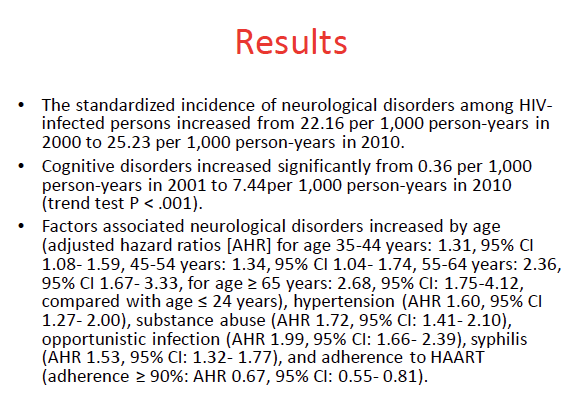 |
 |
 |
| |
Incidence [increased a lot with aging] of neurological disorders among HIV-infected individuals with universal health care in Taiwan, 2000 through 2010
|
| |
| |
Reported by Jules levin
Durban 2016 july 18-22
Presenter
Yen-Chin Chen
Authors
Y.-C. Chen1, N.-Y. Ko2, Y.-T. Tsai3, C.-Y. Hsieh4
Institutions
1National Cheng Kung University, Institute of Allied Health Sciences, Tainan, Taiwan, Province of China, 2National Cheng Kung University, Nursing, Tainan, Taiwan, Province of China, 3China Medical University An Nan Hospital, Nursing, Tainan, Taiwan, Province of China, 4Tainan Sin Lau Hospital, Neurology, Tainan, Taiwan, Province of China
ABSTRACT
Background: Although the introduction of highly active antiretroviral therapy (HAART) has improved the survival of people living with HIV in Western countries, neurological disorders remain a significant burden for HIV-positive people. The study aims to determine the incidence and factors associated with neurological disorders in a large Taiwanese cohort of HIV-infected persons with free access to HAART.
Methods: We conducted a population-based cohort study using the Taiwan National Health Insurance Research Database and identified 13,316 HIV-positive persons from 2000 through 2010. We used direct standardization to calculate age- and sex-adjusted incidence rates based on the 2000 World Health Organization world standard population. Factors associated with neurological disorders were analyzed using a Cox proportional hazards model.
Results: The standardized incidence of neurological disorders among HIV-infected persons increased from 22.16 per 1,000 person-years in 2000 to 25.23 per 1,000 person-years in 2010.
Cognitive disorders increased significantly from 0.36 per 1,000 person-years in 2001 to 7.44 per 1,000 person-years in 2010 (trend test P < .001).
The rate of neurological disorders increased with age (adjusted hazard ratios [AHR] for age 35-44 years: 1.31, 95% CI 1.08- 1.59, 45-54 years: 1.34, 95% CI 1.04- 1.74, 55-64 years: 2.36, 95% CI 1.67- 3.33, ≥ 65 years: 2.68, 95% CI: 1.75-4.12, compared with age ≤ 24 years), hypertension (AHR 1.60, 95% CI 1.27- 2.00), substance abuse (AHR 1.72, 95% CI: 1.41- 2.10), opportunistic infection (AHR 1.99, 95% CI: 1.66- 2.39), and syphilis (AHR 1.53, 95% CI: 1.32- 1.77). The incidence of neurological disorders was negatively associated with adherence to HAART (adherence ≥ 90%: AHR 0.19, 95% CI: 0.15- 0.23).
Conclusions: The rising incidence of cognitive disorders among HIV-positive persons highlights the need to identify the causal factors of these co-infections. Receiving HAART with adherence ≥ 90% contributes to a reduced risk of neurological disorders.



|
| |
|
 |
 |
|
|